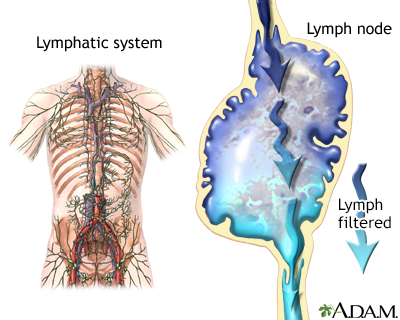Lymph system
The lymph system is a network of organs, lymph nodes, lymph ducts, and lymph vessels that make and move lymph from tissues to the bloodstream. The lymph system is a major part of the body's immune system.
Lymphatics and the breast - Animation
The lymphatic system is often referred to as the body's secondary circulatory system. The lymphatic system collects excess fluid in the body's tissues and returns it to the bloodstream. Lymph formation occurs at the microscopic level. During the exchange of fluid and molecules between the blood circulation and body tissues, blood capillaries may not reabsorb all of the fluid. Surrounding lymphatic capillaries absorb the excess fluid. The fluid is then filtered and transported back by the lymphatic system into large veins near the heart. The lymphatic system can play a very worrisome role in the spread of breast cancer. Components of the lymphatic system called lymph nodes are distributed at specific locations throughout the body. There is also an extensive network of lymphatic vessels in every woman's breast tissue, which is important in regulating the local fluid balance as well as in filtering out harmful substances. The lymph vessels in the breast may inadvertently supply cancerous cells with access to a highway along which the cancerous cells can move to other parts of the body. This process is called metastasis and may result in the formation of a secondary cancer mass in a different location of the body. Regular breast self examinations can help to detect tumors earlier in their growth, hopefully before they spread quickly or metastasize.
Information
Lymph is a clear-to-white fluid made of:
- White blood cells, especially lymphocytes, the cells that attack bacteria in the blood and body tissues
- Fluid from the intestines called chyle, which contains proteins and fats
Lymph nodes are most often soft, small, round- or bean-shaped structures. They usually cannot be seen or easily felt. They are located in clusters in various parts of the body, such as the:
- Neck
- Armpit
- Groin
- Inside the center of the chest and abdomen
Lymph nodes - Animation
The lymphatic system has two main functions. Its network of vessels, valves, ducts, nodes, and organs helps balance the body's fluid by draining excess fluid, known as lymph, from the body's tissue and returning it to the blood after filtering it. Some types of blood cells are also made in the lymph nodes. The lymphatic system also plays an important role in the body's immune system. Infection, even a trivial infection is, the most common cause of swollen lymph nodes. Let's look at a cut section of a lymph node to see what happens. Afferent means towards. Afferent lymph vessels bring unfiltered fluids from the body into the lymph node where they are filtered. Efferent vessels, meaning away from, carry the clean fluid away and back to the bloodstream where it helps form plasma. When the body is invaded by foreign organisms, the swelling sometimes felt in the neck, armpits, groin, or tonsils comes from the microorganisms trapped inside the lymph nodes. Eventually, these organisms are destroyed and eliminated by cells that line the node walls. Then the swelling and pain subside.
Lymph nodes mainly store immune cells that help the body fight infection but are also places where these cells can be made. They also filter the lymph fluid and remove foreign material such as bacteria and cancer cells. When bacteria are recognized in the lymph fluid, the lymph nodes make more infection-fighting white blood cells. This causes the nodes to swell. The swollen nodes are sometimes felt in the neck, under the arms, and groin.
Cancer
Cancer is the uncontrolled growth of abnormal cells in the body. Cancerous cells are also called malignant cells.
Read Article Now Book Mark ArticleSwollen nodes
Lymph nodes are present throughout your body. They are an important part of your immune system. Lymph nodes help your body recognize and fight germ...

The lymph system includes the:
- Tonsils
- Adenoids
- Spleen
- Thymus
Reviewed By
Linda J. Vorvick, MD, Clinical Professor, Department of Family Medicine, UW Medicine, School of Medicine, University of Washington, Seattle, WA. Also reviewed by David C. Dugdale, MD, Medical Director, Brenda Conaway, Editorial Director, and the A.D.A.M. Editorial team.
Ball JW, Dains JE, Flynn JA, Solomon BS, Stewart RW. Lymphatic system. In: Ball JW, Dains JE, Flynn JA, Solomon BS, Stewart RW, eds. Seidel's Guide to Physical Examination. 10th ed. Philadelphia, PA: Elsevier; 2023:chap 10.
Hall JE, Hall ME. The microcirculation and lymphatic system: capillary fluid exchange, interstitial fluid, and lymph flow. In: Hall JE, Hall ME, eds. Guyton and Hall Textbook of Medical Physiology. 14th ed. Philadelphia, PA: Elsevier; 2021:chap 16.




 All rights reserved.
All rights reserved.